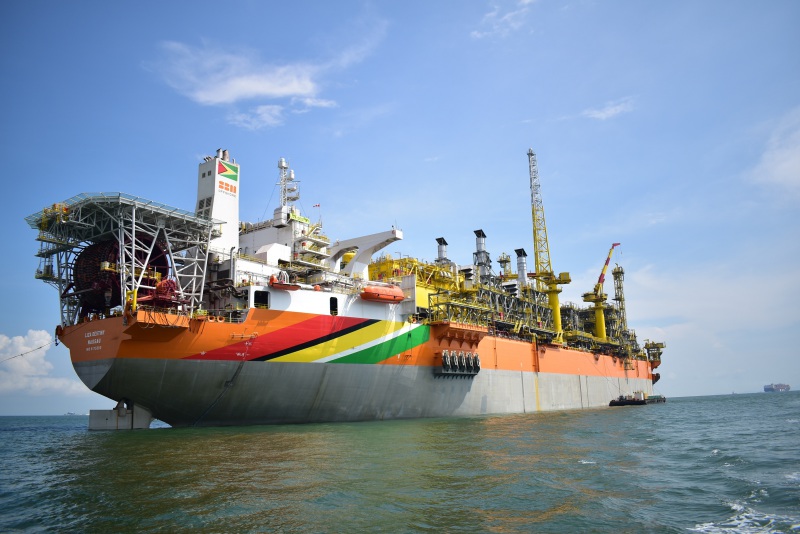In the wake of equipment problems on its offshore platform, ExxonMobil yesterday said that it has cut oil production but it didn’t say by how much and there is no word on the volume of gas being flared which has become a major environmental issue.
Flaring is likely to go on for some time at the Liza Destiny Floating Production, Storage and Offloading (FPSO) platform until an assessment and subsequent repair of the gas compressor that malfunctioned by the manufacturer in Germany.
Yesterday, Natural Resources Minister Vickram Bharrat told Stabroek News that production per day offshore remains around 115,000 to 120,000 barrels per day (bpd), which was at odds with what Exxon said.

“Production level has been maintained. The compressor problem has no impact on production,” Bharrat told this newspaper yesterday when contacted for an update.
Asked about the timeframe for fixing the compressor problem, Bharrat said, “Without an assessment from SBM and ManTurbo, the manufacturer in Germany, we cannot say at this point”.
Asked about the daily gas flaring volume and production figure, Bharrat said those numbers are given to the government every 48 hours and estimated that production was around 115,000 to 120,000 barrels per day.
He would later advise that he would get the exact figures for this newspaper but up to press time this was not done.
Repeated calls yesterday to the Environmental Pro-tection Agency’s acting Director, Sharifah Razack’s office went unanswered.
ExxonMobil yesterday issued an update on the compressor problem six days after it occurred and after numerous media requests for information. It said that it had removed the faulty compressor from its Liza Destiny offshore platform for repairs overseas and that production levels had been cut to limit the controversial flaring of gas.

“A technical team has safely removed the 3rd stage compressor from the package enclosure on the Liza Destiny and is preparing it for transport onshore. An initial examination determined that the unit has to be sent for repairs in Germany where it is expected to arrive on February 9. The full extent of the damage will not be known until a detailed inspection of the compressor can take place at the workshop of the manufacturer, MAN Turbo in Ger-many,” the statement said.
“I wish to assure you that teams of experts from ExxonMobil, SBM Off-shore and MAN Turbo are working diligently to fix the compressor and return it to service as quickly as possible,” ExxonMobil’s Country President Alistair Routledge was quoted as saying.
“We have lowered production levels on the Liza Destiny since the compressor failed and continue to seek ways to reduce flaring. We are currently injecting or using 88 percent of the gas produced from the wells. We share a common interest in responsible management and appropriate standards for development of the country’s natural resources,” he added.
ExxonMobil Guyana said that is providing daily updates to the relevant government agencies.
It is unclear if the cut in production was from levels over the 120,000 barrels per day maximum capacity. Exxon’s partner, Hess, had told its fourth quarter Earnings Call last week that production levels had been over the 120,000 barrels mark and they were looking to increase it.
After announcing only in December last year that it had rectified gas compression problems on the Liza Destiny FPSO vessel, which saw the company flaring over two billion cubic feet of associated gas in 2020, ExxonMobil on January 29th said that it had begun flaring again after experiencing another issue with its compressor seal.
Unfortunate incident
“There was a technical issue regarding a seal on the gas compressor on Liza Destiny. This unfortunate incident resulted in us having to temporarily increase our flare above pilot levels in order to maintain safe operations,” Exxon said in a brief statement.
From the beginning of production in December of 2019, ExxonMobil had been beset by technical problems in meeting its target of 120,000 barrels of oil per day, which saw large volumes of gas being flared.
The large amounts flared from its offshore operations prompted the EPA under its former Director Vincent Adams to put the company under close scrutiny. He had production rates reduced to, at one time, 30,000 bpd and flaring of gas between 10 and 15 million cubic feet per day.
The January 29th compressor problem saw the company being flayed by Adams for continuing its maximum production. Adams, who was sacked by the PPP/C government last year, said that he had cautioned against allowing the maximum production rate and advised that a plan be devised to “keep stability in the reservoir.” Adams said that the company should be asked to address the problems with alacrity.
“Operating full blast is not emergency. You cannot tell me that you are producing at full capacity and call that an emergency situation. The permit specifically prohibits flaring under normal operations. So what then is happening here? Something is wrong with that whole picture,” he contended.
“They should not continue producing at maximum and production should have gone to minimum to keep stability in the reservoir. If they are flaring with those production rates, that is a whole lot of flaring,” he added.
The Minister of Natural Resources had said that government was disappointed at the latest problem and had asked ExxonMobil to replace the defective platform seal as soon as possible.
Yesterday, he reiterated that position and said that government’s own technical team was working along with the company so that the desired goal of rectifying the problem in the shortest possible time is realised. “We have our technical team working also but we have to wait on MAN Turbo and the assessment and then see how quickly this can be fixed,” he said.









